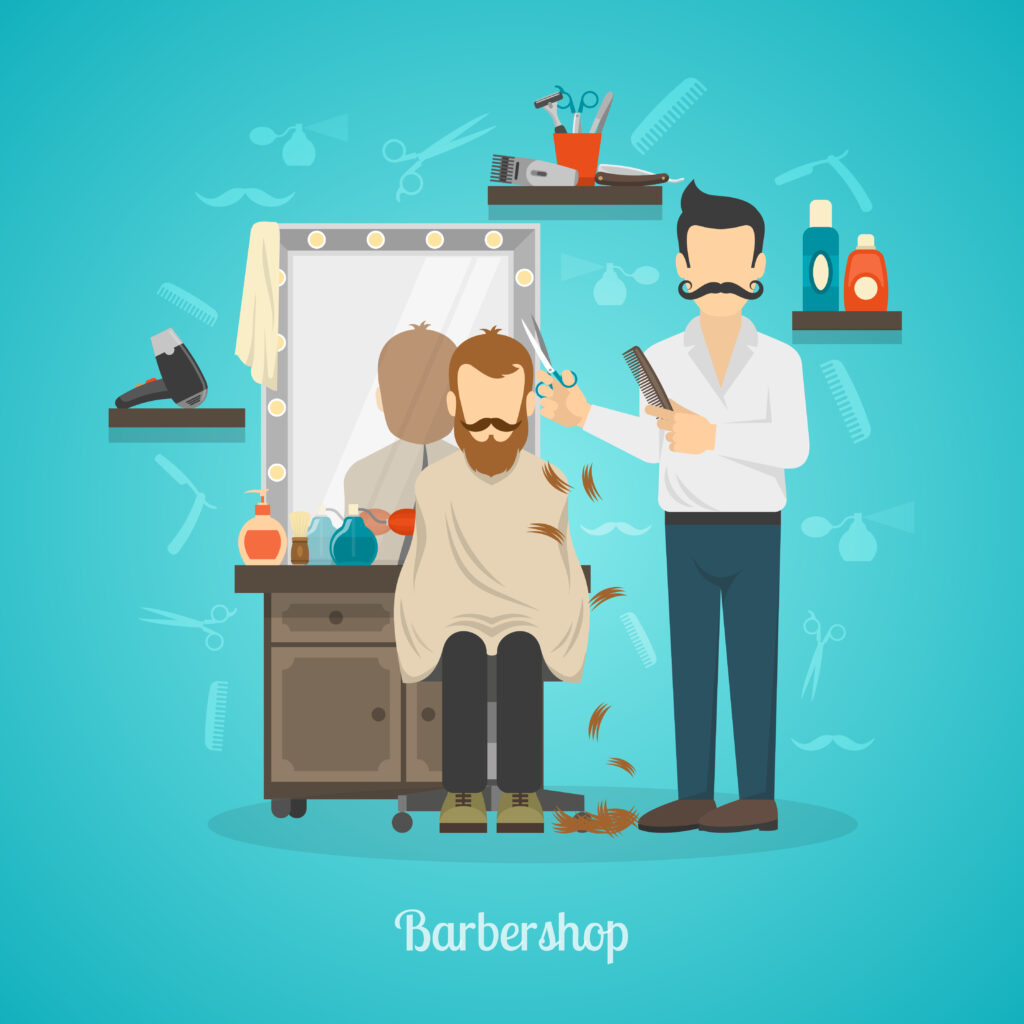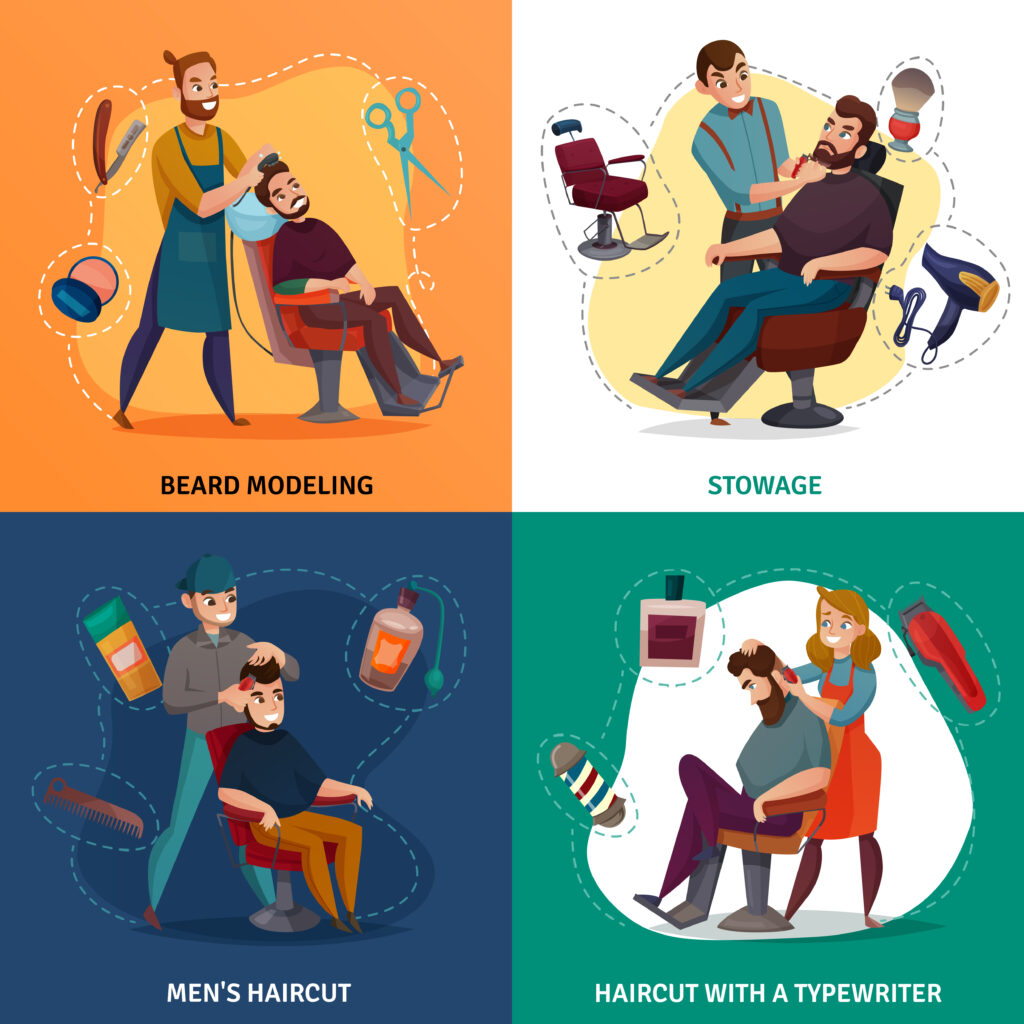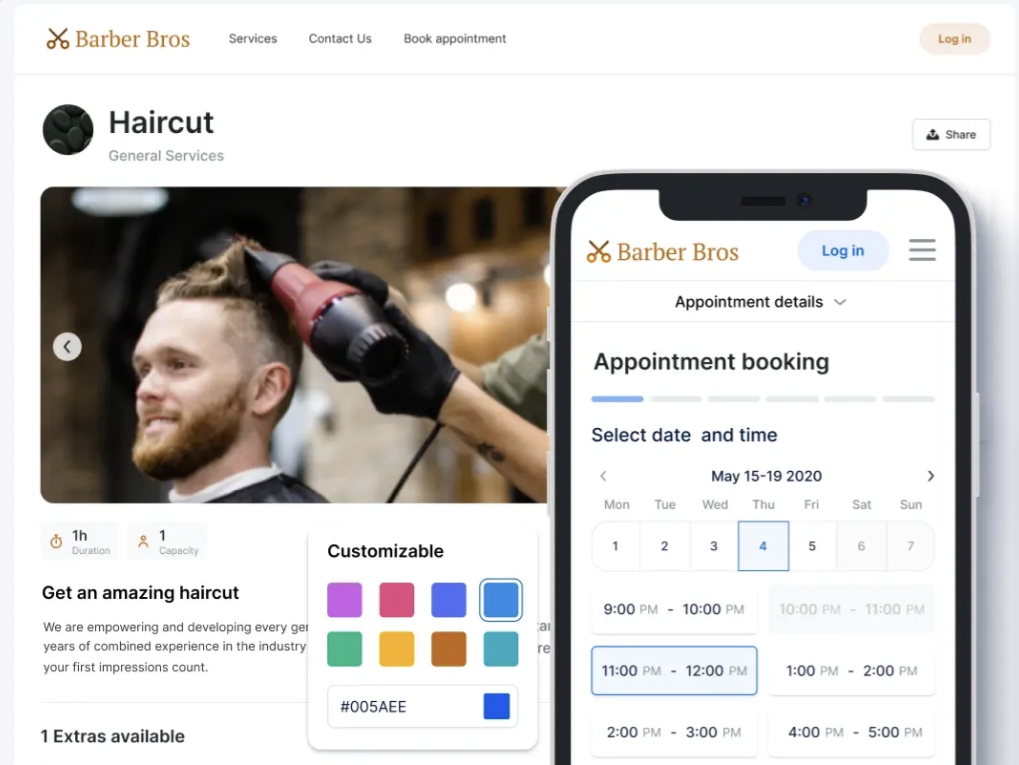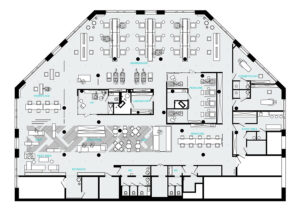You're opening barbershop and stuck on how to create barbershop business plan?
With the right guidance and resources, you can create a comprehensive and successful plan to help increase your chances of success and achieve your goals.
While there are many general templates and guides available, a successful business plan must take into account the unique aspects of your barbershop, including your location, target market, competition, pricing strategy, and services offered. Additionally, it's important to consider factors such as the local economy, industry trends, and regulatory requirements.
So, let’s dive right in!
What Is a Barbershop Business Plan?

Image by macrovector on Freepik
A barbershop business plan is a written document that outlines the key aspects of a barbershop business, such as its goals, strategies, target market, competition, financial projections, and operational requirements.
A well-crafted business plan is essential for any entrepreneur who is starting or expanding a barbershop, as it provides a roadmap for success and helps secure financing from investors or lenders.
Typically, every business plan for a barber shop includes sections on market analysis, marketing and sales strategies, management structure, financial projections, and risk management.
By creating a comprehensive business plan, you as a barbershop owner can better understand the challenges and opportunities facing your business, and develop strategies to overcome obstacles and achieve your goals.
Why Is a Sound Business Plan Essential When Starting a Barbershop?
Having a sound business plan when starting a barbershop is beneficial for several reasons:
Provides a roadmap for success: A well-crafted business plan outlines the key aspects of your business, allowing you to stay focused and motivated, and to make informed decisions about how to grow and manage your business.
Helps secure financing: Lenders and investors will want to see a business plan before providing funding. A comprehensive business plan demonstrates you have carefully considered the risks and opportunities of the business and know how to make the business profitable.
Identifies potential challenges: A business plan can help identify potential difficulties and obstacles that your barbershop may face. By anticipating these issues, you can develop strategies to mitigate risk and respond to challenges as they arise.
Guides decision-making: A business plan provides a framework for decision-making, ensuring that you make informed decisions that are consistent with the overall strategy and goals of the business.
Overall, a carefully thought-out business plan is crucial when starting a barbershop because it helps your stay focused, secure funding, anticipate challenges, and make informed decisions that will help the business to grow and succeed.
Key Components of Barbershop Business Plan
The process of creating a business plan for a barbershop can seem daunting at first, but it's important to remember that every plan is unique to the specific business it represents.
While there may be some common elements to all successful plans, there is no one-size-fits-all approach. Therefore, it's normal to feel overwhelmed when initially attempting to craft the perfect plan.
However, there are certain key points that each barbershop business plan should cover:
- Executive summary
- Company description
- Market analysis
- Products and services
- Marketing plan
- Sales plan
- Competitor analysis
- Financial projections
- Management and organization
- Operations plan
- Risk management
- Appendix
Executive summary
An executive summary of a business plan for a barber shop should provide a brief overview of the key elements of the plan.
When writing the executive summary, focus on providing an outline of the business concept, its unique value proposition, target market, competitive advantage, and financial projections. Moreover, highlight the key strategies for marketing, operations, and management.
With the executive summary, you get a clear and concise outline of your business plan that highlights the most important aspects of the plan and generates interest in potential investors, lenders, and partners.
Company description
The company description gives a detailed overview of your business.
Include information such as the legal structure of the business, the location of the barbershop, the products and services offered, and the mission and vision statements.
Additionally, this section should provide information on the barbershop's history, such as how and when it was founded, and any major milestones achieved so far. The company description should also highlight the target market and any unique selling points or competitive advantages the barbershop has.
You should aim to provide a comprehensive picture of the barbershop and its place in the market.
Market analysis
The goal of market analysis is to provide an in-depth understanding of the industry and target market.
Start the analysis with an overview of the industry, market size, growth trends, and key players.
Also, provide a detailed analysis of the local market, including demographics, buying behavior, and trends. This analysis should identify the specific customer segments that your barbershop will target, such as young professionals, families, or seniors.
The market analysis will help you gain an insight into market trends, such as changes in customer preferences, emerging technologies, and new regulations that may affect the success of your barbershop business.
Products and services

Image by macrovector on Freepik
When making a business plan for your barbershop, don’t forget to consider the products and services you want to offer.
Describe your offer in detail and list all the services you plan on having, such as haircuts, beard trims, hot towel shaves, and other grooming services. Include the different types of haircuts and styles that the barbershop will offer, such as classic cuts, modern styles, and specialty cuts.
In addition to services, list any products that you’ll sell in your barbershop, such as hair care products, beard oils, and shaving supplies. Describe the different types of products, their benefits, and how they complement the barbershop's services.
It is important to highlight the unique aspects of the barbershop's services and products, such as the quality of the products, the skill, and expertise of the barbers, or the use of specialized tools and techniques. This can help differentiate the barbershop from competitors and attract customers.
Marketing plan
How do you plan on advertising your barbershop business? Which channels will you use? How are you going to attract new and retain existing customers? How will you handle your reputation?
The answers to these (and many other questions) should be found in your marketing plan section.
Outline the channels you’ll use to reach customers, such as social media, local advertising, email marketing, or partnerships with complementary businesses. For email marketing and outreach, consider using email outreach tools to streamline your efforts and reach potential customers more effectively. These tools can help you automate personalized emails, track responses, and manage follow-ups, making your outreach efforts more efficient and targeted.
Also, set aside a budget for marketing expenses and metrics for measuring the success of the marketing efforts, such as the number of new customers acquired, customer retention rates, or revenue generated from marketing promotions.
Sales plan
A sales plan section typically outlines specific strategies and tactics for increasing the revenue and profitability of your barbershop.
When developing your sales plan, first focus on setting your sales goals and objectives. Start small and set reachable goals and aim higher as your business flourishes. Some of your goals could be increasing revenue by a certain percentage, selling a certain number of retail products each month, or increasing the average sale amount per customer.
Next, ensure that your marketing tactics actually target your ideal customers. Remember, your goal is to make your services and products appealing to the right clients in order to increase revenue.
A pro tip to skyrocket your sales: create service packages. Develop service packages that bundle together multiple services or offer discounts for purchasing multiple services at once. This can encourage customers to spend more money during each visit.
Moreover, train barbers to upsell and cross-sell during each appointment. Have them offer additional services or suggest retail products that complement the customer's haircut.
Another strategy worth considering is creating loyalty programs that reward repeat customers. Offer them a discount after a certain number of visits or provide exclusive access to promotions and events.
Competitor analysis
Competitor analysis helps you identify direct and indirect competitors, their strengths and weaknesses, and the strategies they use to attract customers.
Additionally, this section should highlight the unique selling point of your barbershop and explain how it will differentiate itself from competitors. It should highlight the competitive advantage you offer, such as unique services, location, or pricing strategy.
In addition, this analysis should reveal any potential opportunities or threats posed by competitors.
The main goal of the competitor analysis is to give you a comprehensive understanding of the competitive landscape and help you identify strategies to gain a competitive advantage in the market.
Financial projections
Financial projections are an important aspect of any business plan because they give a detailed financial forecast of the expected revenue and expenses over the next three to five years. They provide a detailed breakdown of the startup costs, like equipment, inventory, and initial marketing expenses.
Also, the section typically includes a projected income statement, balance sheet, and cash flow statement. These financial statements should detail the expected revenue, cost of goods sold, gross profit, operating expenses, and net profit over the next few years.
It is important to use realistic assumptions when creating financial projections, based on market research and industry benchmarks. Take into account the average price per haircut, the number of customers per day, and the average revenue per customer.
Finally, don’t forget about a break-even analysis, which calculates the amount of revenue needed to cover the barbershop's fixed and variable expenses. This analysis can help determine the barbershop's profitability and financial viability.
Management and organization

The management and organization section of a business plan you create for your barbershop should outline the key people involved in running the business, their roles and responsibilities, and the overall structure of the organization.
First off, describe the key members of the management team, including their experience, qualifications, and responsibilities. Include yourself, managers, barbers, receptionists, and any other staff involved in the day-to-day operations.
Next, define the organizational structure of the barbershop, i.e. how the different roles and responsibilities are divided.
Then, outline the staffing plan for the barbershop, in which you specified the number of staff required, their roles and responsibilities, and the process for hiring and training new employees.
Furthermore, describe the policies and procedures that will be in place to ensure the smooth running of your barbershop. Give a brief explanation of the operational procedures, health and safety policies, and customer service standards.
Don't forget to define the legal structure of the business - be specific about whether it is a sole proprietorship, partnership, or limited liability company (LLC). Mention any necessary licenses or permits required to operate the business.
Operations plan
The operations plan outlines the day-to-day operations of the barbershop, including inventory management, customer service, and scheduling.
Begin with describing the process for managing inventory - how supplies will be ordered, received, and stored, and how inventory levels will be monitored and controlled. Also, take into account the equipment and supplies that will be required to operate the barbershop, like chairs, clippers, scissors, towels, and other tools and materials.
Move on to outlining the customer service policies and procedures needed to maintain the highest levels of quality and ensure that customers leave your barbershop satisfied. Train your staff on how to interact with customers and handle complaints.
When it comes to scheduling, give a brief overview of how appointments are scheduled, managed, and tracked. Outline the appointment booking process, such as whether customers can book online, via phone, or in person. How will walk-ins be managed and fit into the schedule? Also, explain how your team handles appointment confirmation and reminders. Additionally, you may also outline staffing needs for the shop and provide information on how many barbers are needed during peak hours and how to manage schedules to ensure customer demand is met.
Sounds overwhelming? Now is a good time to consider using an appointment booking automation tool to help you manage bookings, employees, customers, payments, and other time-consuming tasks you face every day as a barbershop owner.
How can a booking automation solution help you?

Using booking software can help automate many aspects of your everyday barbershop's operations. However, not every booking software can cut it - you need a solution powerful enough to handle the demands of a busy barbershop and yet intuitive enough to provide a completely hassle-free experience that both you and your customers will love.
The good news is that such a solution exists, and its name is Trafft.
Trafft is a barbershop appointment software designed specifically for the needs of barbershops and similar businesses.
With Trafft, customers can easily book appointments online, which gives them full control of the entire scheduling process. By enabling self-service bookings to your clients, you and your team have more time to focus on providing better services and growing your business. With Trafft, you can create barbershop booking website in minutes.
Trafft also helps barbershops manage their schedules more effectively, allowing them to optimize appointment slots, avoid double bookings, and increase their productivity.
In addition, Trafft offers features such as automated appointment reminders and follow-up messages, which can boost customer communication, satisfaction, and loyalty.
Furthermore, Trafft provides insights into key performance metrics such as sales tracking and reporting, allowing barbershops to make data-driven decisions and optimize their business operations.
Interested? Check out all the features and integrations Trafft brings to the table and start streamlining your operations.
Risk management
Risk management provides a brief assessment of the risks facing the barbershop business, such as legal and regulatory risks, competitive risks, and financial risks. Also, this section should include a plan for managing and mitigating these risks.
Start with identifying some common risks that barbershops may face, like property damage, theft, employee injuries, and lawsuits.
Next, outline steps to prevent these risks from occurring, such as implementing security measures, ensuring proper training and safety protocols are in place, and having insurance coverage.
Additionally, outline a response plan in the event of a risk, such as how to report incidents, manage customer complaints, and handle emergencies.
Effective risk management can help barbershops protect their business, employees, and customers from harm, and maintain a positive reputation in the community.
Appendix
Although not mandatory, a well-structured appendix can strengthen the credibility of your plan. It allows you to give further details or extra information that might be of interest to investors or managers.
Include any additional documents, charts, graphs, tables, materials, resumes, important policies, financial statements, agreements, contracts, and relevant documents that are referenced in the business plan.
Barbershop Business Plan Example
Section |
Details / Example Content |
|---|---|
Executive Summary |
Introduce your barbershop concept, target market, and unique value proposition. Example: “Classic Cuts aims to provide modern grooming services with an old-school barbershop vibe in downtown Chicago.” Include financial goals and projected revenue. |
Company Description |
Describe your business structure, location, mission, and vision. Example: “Classic Cuts is a limited liability company founded in 2025, focused on offering premium barbering services for men aged 20–45.” |
Market Analysis |
Outline your target market, industry trends, and local demand. Include demographic data, spending habits, and customer preferences. Example: “The men’s grooming market is growing 5% annually, with increasing demand for high-end experiences.” |
Products and Services |
List the services and add-on products offered. Example: “Haircuts, beard trims, shaves, scalp treatments, and grooming products like pomades and oils.” Highlight any signature services or memberships. |
Marketing Plan |
Describe how you’ll attract and retain customers. Example: “Use social media campaigns, influencer partnerships, Google My Business optimization, and referral discounts.” Mention branding, pricing strategy, and promotions. |
Sales Plan |
Explain your pricing structure, upselling strategy, and sales goals. Example: “Target 300 clients per month at an average ticket of $30 in the first year.” |
Competitor Analysis |
Identify direct competitors and compare pricing, services, and customer experience. Example: “Unlike nearby budget salons, Classic Cuts offers personalized service, premium ambiance, and online booking.” |
Financial Projections |
Include estimated startup costs, revenue forecasts, and profit margins. Example: “Startup costs: $60,000; Year 1 revenue: $120,000; break-even within 10 months.” |
Management and Organization |
Detail ownership structure and key team members. Example: “Owner: John Doe, Master Barber with 10 years of experience; one part-time assistant and two junior barbers.” |
Operations Plan |
Describe daily operations, staffing, equipment, and workflow. Example: “The shop will operate 6 days a week with 3 barbers working in shifts; appointments managed via online booking system.” |
Risk Management |
Identify potential risks (e.g., staff turnover, competition, economic downturn) and mitigation strategies. Example: “Maintain client database for loyalty offers, invest in staff training, and diversify services.” |
Appendix |
Add supporting materials like licenses, permits, floor plans, or branding mockups. Example: “Include supplier list, financial statements, and lease agreements.” |
Pro Tip: How to Make Your Barbershop Business Plan a Successful One?
We have to make one thing clear here - not every business plan will deliver your barbershop equal value. Some plans are more beneficial than others. Or, to put it like this - making a plan is not the same as making the plan.
But how to know your plan is the plan?
Besides following the structure we mentioned earlier, there are certain aspects to pay special attention to if you wish to transform an average barbershop business plan into an exceptional one.
Ensure your barbershop plan is dynamic
Creating a dynamic barbershop business plan is essential if you want to be able to actually rely on your plan. A dynamic plan allows for flexibility and adaptability as your business evolves and changes over time. It should be a living document that is reviewed and updated regularly to reflect changes in the market, competition, and internal operations.
With a dynamic business plan in place, you'll be able to navigate the challenges of running a successful barbershop and achieve long-term success.
Set realistic goals
Setting realistic goals is also an important step in making a sound business plan for your barbershop. Your goals should be specific, measurable, achievable, relevant, and time-bound (SMART).
This will help you to create a clear roadmap for achieving your objectives, and enable you to track progress effectively, ensuring your plan remains relevant and achievable over time.
Rely on data
Data is your friend, so make sure you rely on it when making any decisions concerning your business. Gathering and analyzing data can help you make informed decisions about your business strategy and identify opportunities for growth and improvement.
You can gather data on your target market, including demographics, behavior patterns, and purchasing habits, as well as data on your competitors, such as their pricing strategies, marketing tactics, and customer feedback. You can also collect data on your own business operations, such as sales figures, customer feedback, and employee performance metrics.
Seek feedback
It's a good idea to seek feedback from colleagues, mentors, and industry experts to ensure that your plan is well-rounded and realistic. They may be able to provide valuable insights and identify potential blind spots that you may have missed. Additionally, sharing your plan with potential investors or lenders can help you secure funding and validate the feasibility of your business idea.
Just be sure to consider the feedback you receive and incorporate it into your plan if it aligns with your vision and goals for your barbershop.
Takeaway
Starting a new barber shop or expanding an existing one requires considerable time, effort, and expertise. However, having a comprehensive business plan can simplify the process.
Similar to having a skilled workforce and top-notch equipment, a well-crafted barbershop business plan empowers owners and managers to stay organized, recognize potential obstacles or prospects for growth, and make informed business decisions.
However, keep in mind that there's more than one approach to developing a business plan. While we recommend you include certain elements, you should create a plan that adapts to your specific situation. Only then you’ll be able to see results. And if you want those results to be truly impressive, discover how you can grow your barbershop with Trafft.
FAQs About Barbershop Business Plan
Can barbers make $100,000 a year?
When it comes to salaried positions, The US Bureau of Labor Statistics calculates the median wage for barbers at $36,150 per year. But realistically, barbers can make between $26,770 to $61,090 yearly. You can make $100,000 if you open your barbershop using a sound business plan.
How profitable is a barber business?
Barbershop business can be extremely profitable, especially if you open multiple salons or even start a franchise. Explore Shave Barbershop franchise and their road to success with Trafft:
How do I start my own barbershop?
The first step in how to start a barbershop is to write a business plan. Every successful business starts with a plan. The next steps would be to research the market, plan a budget, funding, legal structure, taxes, get a barber license, choose a location, buy tools, equipments and barbershop software, hire people and market your new brand.
How much would it cost to start up a barber shop?
The cost of starting a barbershop can range from $80,000 to $200,000 or more. This price includes the following:
- $5,000-$10,000 for barber school
- Various prices to rent, lease, or buy a barbershop
- Construction costs to renovate or build your barbershop
- $1,000+ for registration fees
- $3,000+ for license and permit fees
- $2,000+ for insurance
- $50,000+ for furniture, equipment, and supplies like chairs, scissors, clippers, brushes, etc.
- $3,000+ for marketing materials
- $1,000-$3,000 for a website
- $25,000 for franchising fees if investing in one






